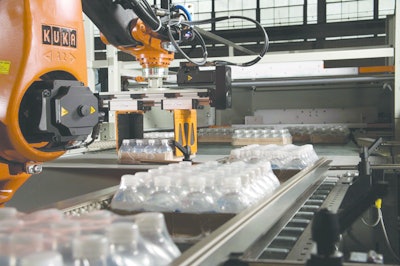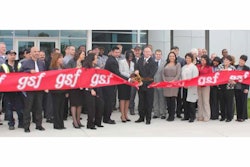
Warehouse automation has been getting a lot of attention lately as food and beverage companies struggle to deal with a proliferation of SKUs, labor issues, and pressure from retailer grocers for smaller, more frequent orders. Underlying these challenges are demands for faster and more flexible delivery and greater order accuracy.
It’s not surprising that most companies don’t have the option for greenfield construction—instead, they’re looking at how to retrofit their existing DCs to not only keep pace with today’s demands, but position themselves for what’s ahead.
The view from above
While the recession kept a lot of non-critical spending on hold, many companies have arrived at a “tipping point,” according to Mike Kotecki, senior vice president at Dematic.
“People are generally confident about the economy, they’re hiring again. Some are more comfortable doing point solutions, while others are ready to ‘rip the lid of this thing’ and blow their competitors out of the water,” he says.
Aside from an improving economy, a number of other factors are pushing companies to make automation and technology investments now, as opposed to later, with SKU proliferation being one key driver.
Brian Sherman, vice president of accounts for WITRON, says grocery retailers’ DC retrofits are oftentimes in response to SKU proliferation, which is occurring in part because of combined growth in private label and brand name products.
“Some estimates are that SKUs are growing 1 to 3 percent annually,” Sherman says.
Paul Deveikas, division president of engineering integration at Wynright Corporation, is also hearing from his customers about capacity constraint issues due to SKU growth.
“Their DCs are typically designed for storage, not flow-through, which means pallet handling rather than less-than-pallet or case handling, and it’s a significant change for them,” he explains. “Furthermore, DCs are faced with managing higher volumes or orders comprised of smaller quantities. That’s a particular issue for the food and beverage industry and it’s really impacting their route cycles—increasing routes, managing routes, hitting route windows—it’s become very complex today.”
Deveikas says that DCs have tried to keep up by using floor locations for case picking, but with ongoing SKU growth “they’re simply running out of floor pallet locations.” And, while some DCs are looking for case storage locations for picking, “that ends up driving replenishment labor, which is unnecessary and nobody wants to do it.”
Introducing different types of vehicles in the DC for picking is another way DCs are trying to cope, but that results in more congestion in the aisles, he says.
All eyes are on labor
Without a doubt, labor remains one of the biggest challenges for DC operators, and the long-term outlook is even grimmer.
Baby boomers—those born between 1946 and 1964—added 9.4 million people in the 16-24 age group to the U.S. population during the 1960s, and 7.3 million people in the 1970s. They’ve started turning 65 years old, however, which means that every day for the next 18 years, roughly 10,000 more will hit the age that has traditionally been associated with retirement, according to the Pew Research Center in Washington, D.C.
Not only are many in the labor pool headed for retirement, but the cost of labor coupled with the difficulties in retaining valued labor are real headaches, especially in the less than desirable warehouse sector, says Greg Cronin, executive vice president at Intelligrated.
“In the 1980s, companies who had previously upgraded with a lot of automation suddenly reverted to using more labor in the warehouse. Today, they’ve realized that the costs are too high to continue this way, so they’re considering automation because in addition to being cheaper than labor, it’s also faster and much more accurate,” Cronin says.
Meanwhile, labor at the retail outlet is also a concern, which is one reason that DCs are being asked to design and deliver more shelf-ready packaging and store displays that require minimal work on the clerk’s part to get product onto the shelves. And, while the clerk’s job at the retail outlet has become easier, the DC is now responsible for putting together the various products on the back end so that they’re ready to go on arrival at the store.
WITRON’s Sherman also notes this trend. “Companies are becoming more focused on how they’re shipping product to the store,” he acknowledges. “A lot more are becoming increasingly ‘store focused.’ They’re looking at their whole supply chain and the end game, and their trying to get the product to the store in the best format, with the easiest handling to get it onto the shelves, and at the same time reduce the amount of inventory across the supply chain. So, what you’re shipping on your trailers is changing the philosophy about the DC. In other words, what your store needs is affecting how your DC is adapting.”
In the view of Dematic’s Kotecki, “The labor element is bigger than ever. It’s the least explored, least understood, and most powerful and volatile in the whole supply chain equation. Companies are seeking to reduce labor or at least make the labor they have optimally efficient. For some, that means putting in some point solution technologies that can make the labor they have more efficient, and at the very least, avoid having to hire more people that would end up becoming redundant should we encounter another down cycle.”
As part of the early analysis for retrofit projects, companies need to ask, “Where do I have non-value-added activity?” suggests Kotecki. “And, a lot of that is found in point-to-point movement.”
For Dematic, that has resulted in an uptick in demand for the company’s automated guided vehicles, and not just for traditional applications such as moving pallets or containers from Point A to Point B.
“We’re seeing several new applications emerging,” says Kotecki. “One is the transportation piece, using AGVs to replace people for long-hauls or deadheads. The other is retrofitting existing rack structures with AGV-based technology for pallet movement in terms of replenishment as well as storage and retrieval. I call it the ‘poor man’s ASRS.’ Voice picking to an automated pallet jack is another area that’s getting a lot of interest. In this scenario, a fleet of automated pallet jacks are coupled with a team of pickers, each of whom are assigned to a fairly tight zone. Rather than driving wildly around the warehouse, people are contained with a zone that is served by a fleet of automated pallet jacks. It’s all very synchronized and walking is also cut down drastically. It comes down to reducing human travel and reducing senseless, non-value-added activities.”
There’s also a lot of potential for AGVs to enhance labor in the freezer environment, says Kotecki.
“We did a study a while back that showed that humans who work in a freezer environment are anywhere from 15 to 25 percent less productive than they are in ambient environments, because they have to take breaks to warm up, they’re making more mistakes because they’re hurrying, and they’re just slower in general. So, the improvements that DCs can get with automation in the ambient environment are even greater in the freezer environment, which is prompting ice cream manufacturers and others to look at automation for what it can offer on the manufacturing side as well as the pre-customer stage in their supply chain.”
e-Commerce makes its move
Pete Hartman, president of Retrotech, sees e-commerce as an increasingly significant driver in the retrofit decision making process.
“It used to be that you and I were the order pickers. Now, we sit at our computers and click on what we want and expect it to be delivered to our doorstep within three days. So, e-commerce has ushered in a new level of complexity. Companies like Amazon have been doing it all along, but for many others it’s a new business model and they’re having to adapt and accommodate it within their existing distribution centers.”
Hartman admits that the impact of e-commerce on the food and beverage sector has not been as great as other sectors, such as apparel, for instance, but he believes it’s poised for rapid growth.
“There have been a few interesting starts with online grocery sites like Peapod and a few others. But compared to Amazon, which has made an art out of shipping billions of dollars worth of $20 orders, grocery stores who want to get into e-commerce have to deal with DC operations that for years have been focused on pallet loads, getting stuff to the retail shelves, and manning the cash registers.”
Already, e-commerce has begun to gain traction for products such as cheese, steaks, specialty spices, and other items that aren’t typically found in the neighborhood grocery store. Meanwhile the unbeatable convenience, selection, and speed will help make it more prominent in the food and beverage sector in the near future, says Hartman.
Like other integrators and manufacturers operating in the broad warehouse automation space, Retrotech is seeing a definite rise in activity. Hartman says that companies are turning to automation to respond to complexity, improve velocity, and provide scalability.
“The complexity comes with more SKUs, handling more frequent orders made up of smaller quantities, and organizing the warehouse and the delivery trucks to handle more complex orders and staging them in a specific sequence,” he says. “Velocity is just that—doing it faster—while scalability is being able to adapt to changing demands.”
Hartman says that despite the concerns by some that warehouses need to be expanded in size in order to handle the new demands, “as we increase velocity we find that warehouses actually are sufficient in size and capacity if we’re able to repurpose the space.”
Solutions and strategies
There are plenty of solutions and strategies in the retrofit arena that are being implemented across various sectors, including food and beverage.
Overall, Wynright’s Deveikis sees retrofitting initiatives being propelled by processes, in other words, “how to better handle case quantities, and manage routes and their frequency more efficiently.”
In addition to mechanical automation, technology is also a part of these projects. “However, it’s not about replacing the ERP or WMS, it’s about targeted software solutions,” he says, specifically warehouse control systems (WCS), or middleware products designed to take control of everything that’s being managing within the four walls, such as receiving, storage, and G/L accounts.
Wynright has also developed a robotic truck loader (RTL), which allows CPG companies like snack food manufacturers to use space on trucks more efficiently because it not only loads them, but cubes them, too. The fuel savings alone are impressive, considering that you can get five truckloads of product onto four trucks. Case handling rates and workman’s comp improvements are also key benefits, according to the company.
Dematic is also seeing a lot of interest on the software side. “As a company, we’ve invested heavily in our software area and voice-directed warehouse—not just case picking, but using voice for cycle counting, staging, quality assurance, even kitting or performing other value-added activities,” says Kotecki. “Using voice and light concurrently is also key, because it ultimately makes the human element more efficient.”
The company is one of the top resellers of Vocollect in the nation, says Kotecki. Meanwhile, PickDirector, which he describes as a “WMS Lite,” enables companies to establish a foundation in control and material movement so they can start adding automation and technology.
Dematic’s focus on goods-to-person solutions is another way it’s working to make labor more efficient. “We’ve got a brand new family of very high-speed goods-to-person stations called RapidPick, which allows people to batch pick or individually pick tremendous amounts of material over a short period of time and only walk a couple of feet,” Kotecki adds.
And while DC retrofits are occurring across industry verticals, Kotecki says that, “The food and beverage sector is embracing it perhaps more than others because they view it from a cost reduction standpoint, rather than because of growth, market advantage, or customer service. They’re operating margins are so much thinner. They’re not making a 30 percent margin like Apple does on an iPad, they’re embracing it because ‘I’ve got to take 2 cents out of my logistics costs.’”
When asked about which automation equipment or technologies are hottest right now, Retrotech’s Hartman replies, “It’s really the effective integration of all those things—WMS, voice, equipment—it’s about better integration to meet a particular business need. What we’re going to see more of is relatively complex and tightly integrated systems that are focused on achieving a particular function at a very high level of performance.”
E-commerce Putting New Demands on DCs
While online purchases of apparel and electronics are quite common, the food and beverage sector hasn’t seen the same levels of activity—yet. All that is poised to change soon, and change fast.
According to a report entitled “Capitalizing on Retailer Data Within the CPG Organization,” released by the Grocery Manufacturers Association in early April, “Consumers are connecting with retailers and products in new and innovative ways and, as a result, dramatically changing how and where they make their purchases.” Naturally, the upstream effect will be felt on the DC level.
So, just how are consumers initiating e-commerce transactions and what’s facilitating the growth in e-commerce?
Consumer mobility. The use of mobile devices, especially smartphones and tablets, continues to skyrocket, giving more consumers 24-7 access to the Internet, at speeds nearly identical to those available on their computers at home or work. Mary Meeker of Morgan Stanley predicts that by the end of 2013, mobile Internet users will exceed desktop Internet users. Location-based services, push notifications, transparent pricing and instant mobile delivery of content will drive mobile commerce, continue to change the “where” of shopping purchases and customer interactions, and impact the use of POS promotions and product placement strategies for CPG companies and retailers.
Social media. Consumers in a physical store need no longer rely solely on a salesperson’s assistance or in-store information. Now they can look for recommendations and “likes” from a vast circle of social media sites. Such advocacy-based feedback is extremely powerful and has been identified as a valuable opportunity to capture and leverage data. Establishing a set of standards and a framework for sharing and leveraging social media-related information greatly enhances the impact of the information.
An “app” culture. The use of “apps” as a user-friendly interface for mobile content has greatly increased the appeal of mobile devices; today, 25 percent of adults who download apps use them for shopping. More than 30 percent of all Internet consumers use printable coupons to purchase goods, and apps such as Yowza and Shopkick are only increasing those numbers.
Crowd aggregation. Brand-owning companies and retail organizations are reaching out to capitalize on the collective insights of their shoppers and consumers. Starbucks, Mountain Dew and Procter & Gamble all have highly-referenced examples of capturing consumers’ ideas and insights to increase their products’ attractiveness. Crowds also play a key role in aggregating purchases and promotions, with sites such as Groupon, Gilt Groupe and Vente-Privee combining technology with the value- conscious consumer to offer significant savings while allowing retailers and brands to engage with customers in fresh ways. General Mills became the first CPG company to partner with Groupon in offering customers a sampler pack of goods.
Location virtualization. Shopping in a physical store is becoming less necessary. Capabilities such as Macy’s Virtual Fitting Room and Tesco’s Billboard Grocery Store in South Korea highlight the merger of traditional offline channels with online access.
Mobile scan and pay. Handheld devices bring greater convenience and price transparency to consumers. A shopper can now be in your store, check a price and order from another retailer while still standing in your store. Pricing and inventory strategy is more critical than ever.

















